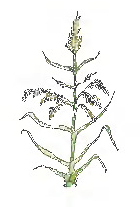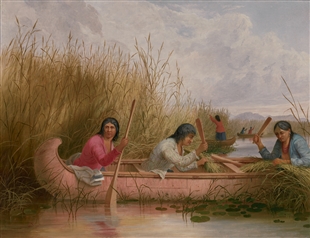
Wild rice, or Manoomin as the Ojibwe people call it, is an ancient grain. Not technically a rice at all, wild rice is a persistent annual aquatic grass found growing in the cool waters of northern Minnesota. Native to Minnesota, wild rice has been used for human consumption for at least 2000 years in the Great Lakes region. It has been found in layers of the earth dated back 12,000 years.
There are more acres of natural wild rice in Minnesota than in any other state in the country, and it has been historically documented in 45 of Minnesota’s 87 counties. Today it is Minnesota’s official state grain.
Why is it labeled wild “rice” when it is a grass? The early European explorers saw the plant growing in water and observed the local people harvesting it. The habitat and harvest reminded them of rice paddies, thus they assumed it was a “wild” rice.
The plant was a chief food for the many tribes in the Great Lakes region (Algonquin, Ojibwe, Dakota, Winnebago, Sioux, Fox, and Chippewa). It was especially valuable because it could be stored indefinitely once it was harvested and dried. Indeed, it was so essential that the Sioux of northeastern Minnesota and the Great Lakes Ojibwe bands battled for more than a century over access to the rich wild rice territories of north Wisconsin.
For the Ojibwe people wild rice has a spiritual and cultural significance. According to their sacred story, their creator, Gichi-Manidoo, had guided them on their westward journey to “the food that grows in water.” This gift from their Creator was nutritious in itself, but also was home to many birds and waterfowl that provided sustenance to the Ojibwe. This food which their ancestors found is still remembered in the wild rice harvest, in ceremonies, and in thanksgiving feasts. They named it Manoomin, which means “good berry.”
Domestic cultivation and combine harvesting of wild rice are relatively recent developments; wild rice is commercially produced as a field crop on about 20,000 acres in Minnesota. For many years, basically all of the wild rice produced in the world came from Minnesota, and a lot of it still does. Wild rice often is harvested from lakes in a traditional way, from canoes, utilizing only a pole for power and two rice beater sticks as flails to know the mature seeds into the bottom of the boat. People interested in harvesting wild rice in Minnesota must first purchase a wild ricing license, similar to a fishing or hunting license. Various American Indian governments and the Minnesota DNR manage wild rice and regulate its harvest.
Populations of wild rice have been gradually declining in Minnesota for many years. Rice can be hurt by pollution, large boat wakes, exotic species and changes in water levels. Scientists are trying to learn more about wild rice and its growth pattern and the reasons for its decline.
Wild Rice Life Span
After ice is out in the spring, wild rice, an annual plant, begins to grow from seeds left in the lake during previous years. The plants grow best in water between 1 to 3 feet deep. The plant surfaces in June and initially floats on the water’s surface with ribbon-like leaves. This period is known as the “floating-leaf” stage of wild rice growth. During this stage, changes in water level, turbidity, or extreme water disruption or flow can uproot the plant. Wild rice plants also suffer when competing with other vegetation in the lake, including water lilies, water shield, and pickerel weed. Sometimes these other plants begin growing in the spring before wild rice and so can take over the water surface. By the end of June the aerial shoots have begun to develop. They will grow into August, reaching a height of 2-8 feet above the water surface.
In late July flowering begins, with both male and female flowers growing on the same stalk, the female flower above the male. The plants are wind pollinated, with seeds on a single stalk reaching maturity over a 10-14 day period. Ripening is affected by water depth, weather, sediment type and other factors. Even with the same bed of plants, the seeds ripen at various times. So harvesting the same area is done repeatedly, generally from late August into September. The seed not harvested will fall into the water and sink, remaining dormant until conditions are right. Usually they will germinate the next year, but the can remain viable for another year or so.
Traditional Harvesting Vs. Commercial Farming

Traditional wild rice harvesting is composed of 5 steps: knocking, drying, parching, hulling, and finally, winnowing. The harvest is done with two people canoeing. One guides the canoe while the other knocks the stalks to harvest the rice. Two knockers are used, one to pull the stalks towards the canoe and the other to lightly brush the stalks so that the grains fall into the canoe. If the grain is not ripe, the wild rice will generally not fall when knocked. So harvesters repeat the process for several weeks. Next, the grains are spread out in a single layer, generally on canvas, sheets or birch bark. The grains is mixed often to remove the debris and to insure that it dries out evenly. Once it is dry, the rice is roasted, or parched in an iron kettle over a small wood fire, and constantly stirred by paddle to avoid burning.
Once roasted, the wild rice is hulled and the chaff is removed from the kernel using one of two methods. More often this is done in a small pit in the ground lined with wood. There the rice is then treaded, or danced on. Poles are used as the dancers tread on the rice in a circular motion to control the pressure put on the rice. The other method is to pound the rice, using wooden pestles dropped onto the rice. Generally 5 or 6 feet in length, these poles put enough weight onto the rice to be hulled to that extra force is not necessary.
The last process, winnowing, removes the chaff from the kernel. The grains are put in a tray and tossed so that the chaff is blown away naturally by the wind. After this final processing, the wild rice can be stored indefinitely.
Growing wild rice commercially was attempted as early as the 1950s. Even when many exacting conditions are met, yields are quite low. Sometimes the yield is as little as 100 to 200 pounds of wild rice per acre. Commercial wild rice farmers must make permanent dikes with consistent water depth in their fields so the wild rice stalks can grow in an aquatic environment. The plants must be thinned once they reach maturity so that there is not overcrowding in the rows. And finally, harvesting must be timed perfectly for high yields as they must drain the fields in order to harvest. In addition to the growing processes, farmers must deal with other issues— maintaining correct and consistent water heights, the problems of shattering seed during strong winds, and fluctuating temperatures that affect the development of the grain. Diseases, including brown spot and stem rot, are also common problems.
Wild Rice and the Environment
Wild rice has great ecological value, and the streams and lakes where it grows abundantly support unusually diverse biological communities. Both migrating and resident wildlife rely on the nutritious and abundant seed of natural wild rice. The dense stands provide roosting areas and brood cover for many waterfowl and other birds. Mammals such as the muskrat use the stalks for food. Wild rice provides food and shelter for many fish and is one of the most important foods for waterfowl in North America. Minnesota DNR’s Comprehensive Wildlife Conservation Strategy lists 17 species of wildlife known as “species of greatest conservation need” that use wild rice lakes as habitat for reproduction or foraging.
In addition wild rice plants in our rivers and lakes prevent the bottoms from eroding. Annual reseeding ensures a stable ecosystem, protecting the other life forms found in these water bodies. By stabilizing water quality, algae bloom is reduced and water clarity increased.
Wild Rice and Nutrition
Wild rice is an excellent grain, low in fat, high in fiber and protein, and gluten free. One cup of cooked rice provides about 6.5 grams of protein, but contains only 166 calories. In addition wild rice contains folic acid, niacin, potassium, zinc and several B vitamins. Recent research at the University of Minnesota indicates that wild rice has anti-oxidant properties and contains many phytochemicals. Research in China (in animal studies) found that wild rice was effective in lowering cholesterol. It has a chewy texture and a nutty flavor.
Did You Know?
- The scientific name for wild rice is Zizania palustris.
- It is found in fresh water lakes of Canada, Michigan, Wisconsin and Minnesota.
- The Algonquin, Ojibwa, Dakota, Sioux, Fox, Winnebago, and Chippewa tribes used wild rice as an important staple in their diets.
- The French explorers called it “foilles avoines” , translated as wild oats.
- When cooked, wild rice expands to 3 or 4 times its size.
- Wild rice is the only cereal grain native to North America.
- Other names for wild rice are Canada rice, Indian rice, and water oats.
- You can pop wild rice, like popcorn. Just heat it in a little oil and shake ‘til it pops.
- Lumberjacks used to eat wild rice for breakfast with milk and honey.
For more information see the 10 Plants That Changed Minnesota MSHS book.